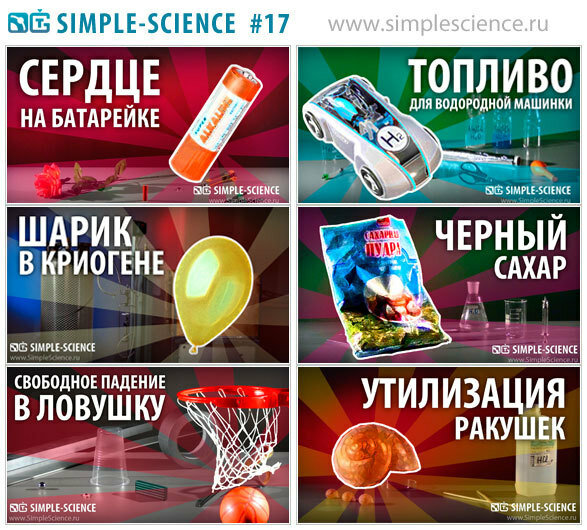Simple-Science - Simple Experiments (Digest # 17)

Today in the issue:
- the simplest battery-powered electric motor;
- balloon and -170 ° C;
- black sugar;
- free fall;
- dissolution of shells;
- fuel for a hydrogen machine.
Attention:
Some experiments may be hazardous to health. When carrying out them, it is imperative to observe safety precautions.See below 6 videos with explanations.
The simplest battery-powered electric motor
Why the wire is spinning
The rotation occurs because an electric charge arises in the wire. And this is nothing more than the ordered movement of charged particles. Each of them is affected by a magnetic field, which deflects the direction of their movement. This deviation is called the power of Lorentz. The physical language is the force with which an electromagnetic or magnetic field acts on a point charged particle. A special case of the Lorentz force is the situation when the magnetic field is directed perpendicular to the velocity vector. In this case, the force becomes centripetal. more details
Balloon and -170 ° C
Why air in the ball is compressed at -170 ° C
The laws of thermodynamics tell us that the pressure, volume and temperature of a gas are quantities that are dependent on each other. And at constant pressure (such a process is called isobaric), the dependence is as follows:

That is, the dependence is direct. The larger the volume, the higher the temperature. The lower the temperature, the lower the volume, etc.
This happens due to a change in the distance between the molecules, which is a consequence of a change in the kinetic energy of the particles due to external influences. more details
Black sugar
Why it happens
How does this happen, and why does a black solid porous object form from white sugar and a clear liquid?
Sucrose is a disaccharide with the formula C12H22O11. This shows that the ratio of H and O atoms is the same as that of water - two hydrogen per oxygen. Concentrated sulfuric acid absorbs water from sugar, and the remaining carbon is released in the form of coal.
Like most sulfuric acid reactions, this reaction is exothermic, that is, it passes with the release of heat. Therefore, the water evaporates and only a dry solid residue remains.
2С12Н22О11 + 2Н2SО4 = 23С + СО2 + + 2SO2 + 24Н2О The
gases formed in the process foam carbon and it becomes porous. more details
Free fall
Why does the ball fall into the trap
Free fall is a straightforward movement. Its direction is always perpendicular to the plane of the surface of the object of attraction. In this case, it is planet Earth. And a bar, in particular. Because it lies parallel to the surface of the Earth.
So, our ball, when the support is removed from under it, begins to move in a rectilinear, perpendicular to the lying bar under the action of gravity. At this time, each point of the strip moves in a circle and lands on the surface of the bar with an offset. Having calculated the displacement empirically, we place our “trap" on this place. more details
Dissolution of shells in acid
Why shells dissolve in acid
The chemical composition of shells in their natural form is as follows: 63-94% CaCO3 (calcium carbonate), 2-25% SiO2 (sand) and other inclusions that make up less than 2%. Insoluble in water - it is a fact - they lived there. What about hydrochloric acid?
Sand with hydrochloric acid does not react. So the main reaction is calcium carbonate. Active chlorine displaces the acid residue in the calcium salt to form calcium chloride and unstable carbonic acid, which decomposes into water and carbon dioxide. The chemical reaction is as follows:
CaCO3 + HCl CaCl2 + H2O + CO2
The reaction is exothermic, like most reactions of strong acids, so it proceeds quite rapidly. The resulting calcium chloride - a colorless salt in the form of crystals - is soluble in water, therefore it is not visualized. Insoluble particles remaining in the solution are sand and other inclusions. As you can see, there are not many of them. more details
Fuel for a hydrogen machine
You can subscribe to new videos on Vkontakte page or look at the site " Physical and chemical experiments ".
